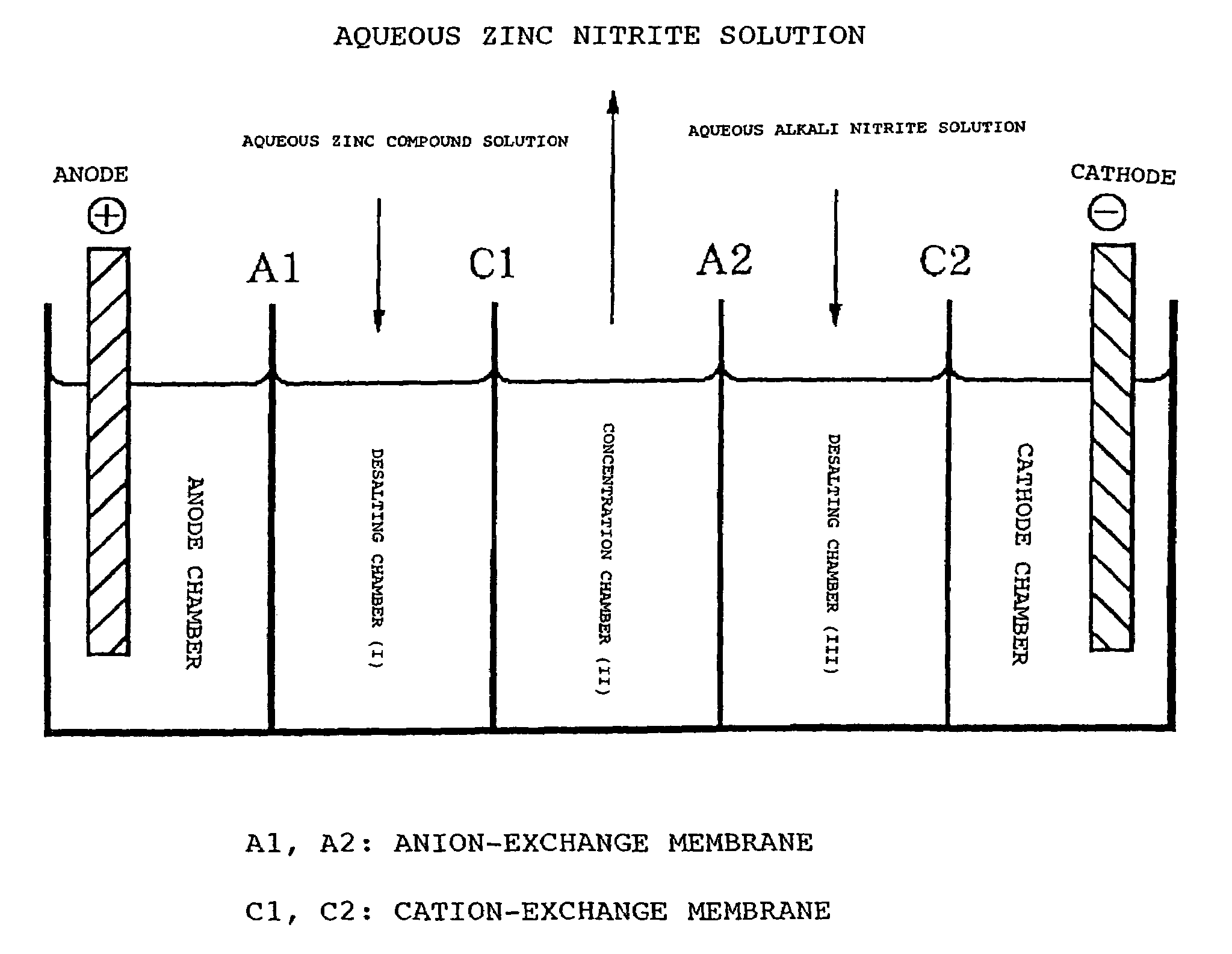Aqueous solution of zinc nitrite and method for production thereof
- Summary
- Abstract
- Description
- Claims
- Application Information
AI Technical Summary
Benefits of technology
Problems solved by technology
Method used
Image
Examples
example 1
[0062]Using a 5-cell electrodialyzer with ion-exchange membranes as illustrated in the figure, only NO2 ions and Zn ions were transferred from an anion-exchange membrane (Selemion AMV; product of Asahi Glass Co.) and a cation-exchange membrane (Selemion CMV, product of Asahi Glass Co.) to obtain an aqueous zinc nitrite solution. The experimental process is as follows.
[0063]Dissolved in deionized water were 575 g of zinc sulfate 7·H2O to prepare a 15% by weight aqueous solution of ZnSO4 and this solution was fed to the desalting chamber (I). On the other hand, 600 g of sodium nitrite were dissolved in deionized water to prepare a 30% by weight aqueous solution of NaNO2 and this solution was fed to the desalting chamber (III).
[0064]A 1.70% by weight aqueous solution of zinc nitrite was placed in the concentrating chamber (II). The anode chamber and the cathode chamber were supplied with a 3.0% by weight aqueous solution of Na2SO4. Anion-exchange membranes (A1, A2) and cation-exchange ...
examples 2 to 5
[0067]The concentration of zinc nitrite prepared by Example 1 was 17% by weight, and the stabilizing agents listed below were added, while assuming that the concentration of the aqueous zinc nitrite [Zn(NO2)2] solution to be 10% by weight as NO2, the sodium ion amount was 1188 ppm, the sulfate ion amount was 10 ppm, and the calcium ion amount was 1 ppm, followed by being sealed and left for 30 days at 5° C. in a refrigerator. After standing, the presence or absence of precipitate was confirmed by visual observation.
[0068]In the table, “absence” means that there was no precipitate.
[0069]Also, in Table 2, “Brending amount” indicates the addition amount with respect to the aqueous zinc nitrite solution.
[0070]
TABLE 2Stabilizing agentBlending amountPresence or absence ofKind(wt %)precipitateExample 2Sodium nitrite2AbsenceExample 3Starch1AbsenceExample 4Citric acid0.5AbsenceExample 5EDTA0.1Absence(Note) ″EDTA″ in Table 2 represents ethylene diamine tetra-acetic acid.
PUM
| Property | Measurement | Unit |
|---|---|---|
| Fraction | aaaaa | aaaaa |
| Fraction | aaaaa | aaaaa |
| Fraction | aaaaa | aaaaa |
Abstract
Description
Claims
Application Information
 Login to View More
Login to View More - R&D
- Intellectual Property
- Life Sciences
- Materials
- Tech Scout
- Unparalleled Data Quality
- Higher Quality Content
- 60% Fewer Hallucinations
Browse by: Latest US Patents, China's latest patents, Technical Efficacy Thesaurus, Application Domain, Technology Topic, Popular Technical Reports.
© 2025 PatSnap. All rights reserved.Legal|Privacy policy|Modern Slavery Act Transparency Statement|Sitemap|About US| Contact US: help@patsnap.com


